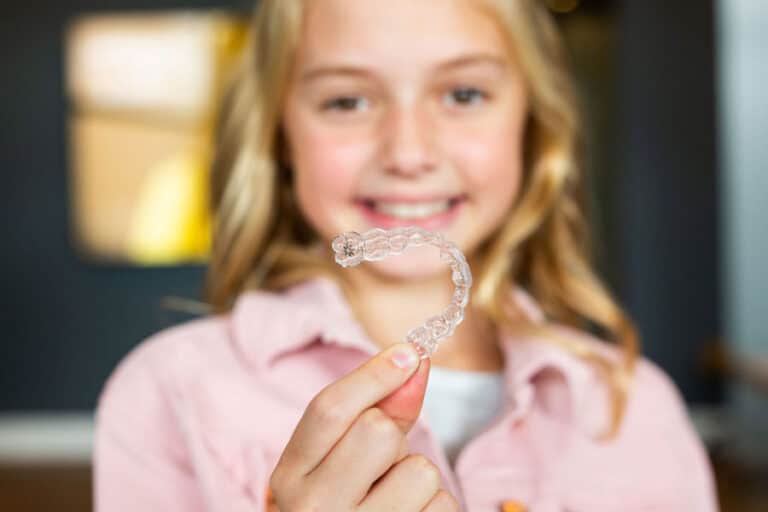As a parent, you want to set your child up for a healthy, confident smile. While braces and orthodontic care are often associated with teenagers, many kids can benefit from treatment much earlier, sometimes before age 10. Catching orthodontic issues early can prevent more serious problems down the road.
At Brookhaven Orthodontics, we specialize in spotting the early warning signs that a young child might need help guiding proper jaw and tooth development. So, how do you know if your child needs to see an orthodontist now rather than later? Keep reading.
Why Early Orthodontic Evaluations Matter
The American Association of Orthodontists recommends that children have their first orthodontic evaluation by age 7. By this age, a child typically has a mix of baby and permanent teeth, making it easier to identify developmental concerns.
Early detection allows orthodontists to guide jaw growth, reduce the need for future extractions, and help permanent teeth erupt in better alignment. It’s not about putting braces on every child—it’s about monitoring growth and intervening at the right time.
Common Signs Your Child May Need Early Orthodontic Treatment
1. Crowded or Crooked Teeth
If your child’s teeth are overlapping, turning, or seem too close together, it could signal a space issue. Baby teeth may look tight, but that’s often a red flag for future crowding as adult teeth come in. Early orthodontic treatments can create space before more serious misalignment happens.
2. Difficulty Biting or Chewing
Watch how your child eats. If they often chew on one side of their mouth, complain of discomfort while eating, or seem to avoid certain foods, there may be a bite problem. Crossbites, open bites, and overbites can affect how efficiently your child chews—and can even impact digestion.
3. Mouth Breathing or Snoring
Frequent mouth breathing, especially at night, may be more than just a habit. It can signal airway issues or improper jaw development. If your child snores, struggles to breathe through their nose, or wakes up tired, an orthodontic evaluation may help get to the root of the problem.
4. Thumb Sucking or Prolonged Pacifier Use
Habits like thumb sucking or using a pacifier beyond age 3 can start to shift the teeth and affect jaw alignment. These behaviours often lead to open bites, where the front teeth don’t come together. Early intervention can help reverse or minimize the damage.
5. Early or Late Loss of Baby Teeth
Baby teeth fall out for a reason—they make way for adult teeth. But when they fall out too early or hang on too long, it can throw off the timing of permanent tooth eruption. Your orthodontist can evaluate whether your child’s tooth loss pattern is on track or needs correction.
6. Jaws That Shift or Make Sounds
If your child’s jaw makes clicking or popping sounds when they open or close their mouth, that could point to a misalignment. You might also notice the jaw shifting to one side when they talk or chew. These signs can mean the bite isn’t developing properly and could worsen over time.
7. Teeth That Don’t Come Together Properly
When your child bites down, do their teeth line up? If the front teeth jut out or the back teeth don’t touch, there could be a bite issue like an underbite, overbite, or open bite. These problems can affect speech, chewing, and even self-confidence if left untreated.
8. Speech Issues
Some speech problems—like lisping or difficulty pronouncing certain sounds—can be linked to how the teeth and jaw are aligned. While a speech therapist can help with language development, an orthodontist may be needed to address the structural causes.
9. Frequent Biting of the Cheek or Lips
If your child often bites the inside of their cheeks or lips accidentally, it may be due to poor alignment of the teeth. This can be more than just an annoyance—it can lead to soreness, infections, or avoidance of certain foods.
10. Visible Gaps Between Teeth
While some gaps between baby teeth are normal, large or persistent gaps could signal missing teeth, abnormal spacing, or issues with how the adult teeth are coming in. Addressing gaps early can help guide teeth into better positions before permanent ones erupt.
What to Expect During an Early Orthodontic Evaluation
Visiting an orthodontist doesn’t mean your child will automatically get braces, Brookhaven. We use the first visit to assess how your child’s teeth and jaws are developing. This includes:
- A visual examination of teeth and bite
- Digital imaging to view tooth position and jaw alignment
- A discussion about your child’s dental habits and history
- Customized recommendations, if any, for monitoring or early treatment
We might suggest a wait-and-see approach with regular check-ups, or we may recommend early intervention to guide development and avoid more complex issues later.
Benefits of Early Orthodontic Treatment
Early treatment—sometimes called Phase I treatment—can offer several advantages:
- Creates space for permanent teeth to grow in properly
- Improves jaw alignment during key growth periods
- Reduces the risk of trauma to protruding front teeth
- Improves facial symmetry and breathing
- May shorten or simplify future treatment in the teen years
In many cases, early treatment makes future orthodontic care easier and more effective.
When to Schedule a Consultation
Even if your child hasn’t shown obvious signs, it’s still smart to book a consultation around age 7. The earlier we catch a potential problem, the more options we have to correct it.
If you’re looking for an orthodontist in Brookhaven who specializes in child and early-phase orthodontics, Brookhaven Orthodontics offers expert care with a compassionate, family-friendly approach.



